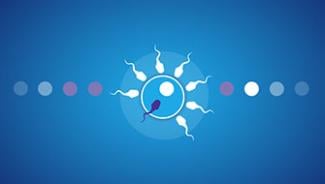What is progesterone? Understanding its role and typical levels

You likely know that progesterone is a hormone that relates to reproductive health. But understanding progesterone’s role in reproduction may help you connect some dots when you’re trying to conceive (TTC). So, what is progesterone, and what does it do? What do typical levels look like? What could low progesterone levels mean? Read on to learn the essentials.
What is progesterone?
Progesterone is a steroid hormone in the class of progestogens. It’s primarily involved with sexual development and reproduction.1
Your body produces progesterone mainly during the second half of your menstrual cycle.2 The first half of your menstrual cycle involves both menstruation and your follicular phase. After you ovulate, you enter your luteal phase. Progesterone is secreted by the corpus luteum, a temporary hormone-secreting gland that forms from a ruptured follicle after it has released an egg, preparing your uterus for the possibility of a fertilized egg.1,3
In addition to the corpus luteum, your ovaries and adrenal glands also produce progesterone in smaller amounts.2 During pregnancy, progesterone is produced by the placenta.2
What does progesterone do?
Progesterone performs many functions, including triggering your monthly period and helping support a pregnancy.
If pregnancy doesn’t occur, the corpus luteum breaks down, which means your progesterone levels begin to drop. You may experience PMS (premenstrual syndrome). Blood and tissue from your uterine lining breaks apart. Your period starts and your menstrual cycle begins again.1-3
If pregnancy occurs, progesterone begins to support the pregnancy by:
- Continuing to thicken the uterine lining (also called the endometrium) by stimulating the growth of blood vessels. A thicker lining can better store blood and nutrients to help nourish the embryo.1,2,4
- Preventing the uterus from contracting and the uterine lining from shedding until the placenta is ready to take over.1
- Promoting a concentration of mucus on the lining of the cervix, creating a barrier against sperm and potential infections.4
Progesterone levels remain high throughout the pregnancy for several reasons. High levels of progesterone help ensure your body won’t produce more eggs and strengthen your pelvic wall muscles to help prepare your body for birth. High levels of progesterone also reduce uterine contractions to prevent premature birth, promote the growth of maternal breast tissue and prevent lactation until it’s time for birth.1,2,4
Once the placenta develops, it also begins to produce progesterone, at first supporting the corpus luteum, and eventually taking over progesterone production between weeks 8 and 12 of the pregnancy (a period referred to as the luteo-placental shift).1,2,4
How do progesterone levels change over time?
Your progesterone levels change throughout your menstrual cycle. Progesterone levels are often low before ovulation (during the follicular phase).5 After ovulation, progesterone levels rise and will continue to rise if pregnancy occurs.5 If pregnancy doesn’t occur, progesterone levels will fall.5
Progesterone levels steadily increase during pregnancy, peaking in the third trimester.5 Those levels tend to decrease after menopause.5
What does having low progesterone mean?
Low concentrations of progesterone have been linked to fertility issues including miscarriage, decreased ovarian function, amenorrhea (which means you don’t have a period), ectopic pregnancy and toxemia in late pregnancy.5-7
What are some signs of low progesterone?
If you’re experiencing abnormal bleeding (spotting between periods, no periods or irregular periods and you’re not pregnant, or if you’re having trouble ovulating or getting pregnant, you may have low progesterone.6 If you are concerned that you may have low progesterone, please reach out to your doctor.
How can you increase progesterone?
Your ob-gyn may prescribe progesterone if your body is producing less of the hormone. First, a quick vocab lesson: “Progesterone” is produced by your body and is in a class of hormones called “progestogens.” “Progestins” are synthetic steroid hormones with progesterone-like properties. 1 Birth control pills are often a combination of progestin and estrogen.1 Progesterone can be prescribed, but it’s still not exactly what’s produced by your body.8 Progesterone can be administered orally, vaginally or via an injection.
How effective is prescription progesterone?
According to the American Society for Reproductive Medicine, while progesterone has proven beneficial for various therapeutic infertility treatments, there has been no evidence that it’s beneficial for promoting fertility in natural cycles or for treating luteal phase deficiency. The data on its effect on recurrent pregnancy loss is conflicting.9
What if my progesterone levels are high?
If you have unusually high progesterone levels, it’s important to remember that the real meaning of those results varies depending on the point in your menstrual cycle when you took the test, as well as your reasons for taking the test. Higher progesterone levels are occasionally observed with some ovarian cysts, molar pregnancies, rare forms of ovarian cancer, adrenal cancer or complications with the adrenal glands.5 High levels can also occur in the case of a multiple pregnancy (like having twins).5,6 Your healthcare provider can help you understand what high progesterone test results might mean for you, and suggest additional tests as appropriate. 6
All in all, progesterone is a pretty remarkable hormone that plays an important role in conception and pregnancy. If you have questions about progesterone and your reproductive health, talk to your healthcare provider. Knowledge and communication are two tools you should feel empowered to use whenever you need them.
Related Articles
Sources
-
Endocrine Society. Reproductive Hormones. Updated January 24, 2022. Accessed February 16, 2023.https://www.endocrine.org/patient-engagement/endocrine-library/hormones-and-endocrine-function/reproductive-hormones
-
Society for Endocrinology. You and your hormones: what is progesterone? Updated March 2021. Accessed February 16, 2023. https://www.yourhormones.info/hormones/progesterone/
-
Cleveland Clinic. Corpus luteum. Updated October 7, 2021. Accessed February 16, 2023. https://my.clevelandclinic.org/health/body/21849-corpus-luteum
-
Cable JK, Grider MH, National Center for Biotechnology Information, National Library of Medicine. Physiology, progesterone. Treasure Island, Florida: StatPearls Publishing. Updated May 8, 2022. Accessed February 16, 2023. https://www.ncbi.nlm.nih.gov/books/NBK558960/
-
Mayo Clinic Laboratories. Progesterone, serum. Accessed February 16, 2023. https://www.mayocliniclabs.com/test-catalog/Overview/8141#Clinical-and-Interpretive
-
MedlinePlus, National Library of Medicine. Progesterone test. Accessed February 16, 2023. https://medlineplus.gov/lab-tests/progesterone-test/
-
Ku C, Allen Jr JC, Lek S et al. Serum progesterone distribution in normal pregnancies compared to pregnancies complicated by threatened miscarriage from 5 to 13 weeks gestation: a prospective cohort study. BMC Pregnancy Childbirth. 2018;18(360). doi: 10.1186/s12884-018- 2002-z. https://bmcpregnancychildbirth.biomedcentral.com/articles/10.1186/s12884-018-2002-z
-
National Center for Biotechnology Information. Compound summary: diosgenin. Accessed February 16, 2023. https://pubchem.ncbi.nlm.nih.gov/compound/Diosgenin
-
Fertility and Sterility. Diagnosis and treatment of luteal phase deficiency: a committee opinion. Updated June 6, 2021. Accessed February 16, 2023. https://www.fertstert.org/article/S0015-0282(21)00128-X/fulltext

When is the best time to get pregnant?
There are only a few days each cycle, around ovulation, when a woman is fertile. Knowing these days can maximise your chance of conceiving.

Get pregnant naturally
Ovulation tests are accurate and simple to use.




